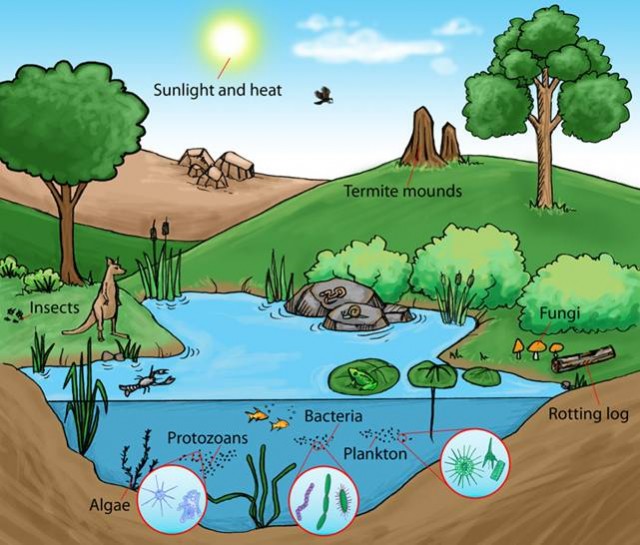ecosystem
THE CONCEPT OF the ecosystem began with the establishment of the science of ecology which is credited to Ernst Haekel, a German zoologist who coined the term ecology in 1869. He based this term on the Greek word oikos, meaning “a place in which to live.” It was another 60 years before the term ecosystem was introduced in 1935 by Sir Arthur Tansley, a British ecologist and supporter of environmental conservation.
In a classic publication in the journal Ecology, Tansley defined ecosystem: “The more fundamental conception is the whole system including not only the organism complex, but also the whole complex of physical factors forming what we call the environment. We cannot separate them (the organisms) from their special environment with which they form one physical system. It is the system so formed which provides the basic units of nature on the face of the Earth. These ecosystems, as we may call them, are of the most various kinds and sizes.”
Thus, an ecosystem comprises a group of coordinated components of the environment; such components may be biotic, that is, relating to life such as plants, animals, humans, or abiotic, that is, relating to non-living components of the environment such as water, soil, climate. All ecosystems are organized and structured; the biotic and abiotic elements and the links between them can be identified and in many cases quantified. All ecosystems function via the relationships between the components. Their natural state is one of dynamic equilibrium whereby a balance exists
between the components that is maintained through negative feedback or self-regulation. Thus, the character and functions of the ecosystem prevail.

If imbalance occurs, because of an external stimulus such as climatic change or an internal agent such as human activity, positive feedback will occur. Alterations in the components and their functions occurs until a new equilibrium, that is, an ecosystem with different characteristics from the original, is reached. The reaction of ecosystem components to positive feedback is rarely immediate because of inherent resilience to change, which takes time to overcome. Consequently, most stimuli will generate a lagged response as thresholds of resistance are overcome. Moreover, ecosystems may be defined at any scale. At one end of the spectrum is the Earth itself, or more specifically the biosphere, which is the zone adjacent to the Earth's surface where all life exists, and at the other end of the spectrum is a small pond. Ecosystems are open systems insofar as they can be influenced by external factors and there may be imports and exports of mass and energy.
One ecosystem function involves the cycling of chemical elements and compounds. This movement of chemicals between the biota, soils, oceans, and atmosphere is biogeochemical cycling. Each chemical has several major pools or reservoirs between which fluxes or exchanges occur. If the atmosphere is involved, the biogeochemical cycle is described as gaseous, but if there is no atmospheric component, the cycle is considered to be sedimentary. Carbon, nitrogen, hydrogen, and oxygen (the latter two are combined as water) have gaseous biogeochemical cycles, as they all have significant reservoirs in the atmosphere.
Moreover, the volumes of these elements, especially carbon as carbon dioxide and methane, in the atmosphere influence climate. Thus the Earth's biotic and abiotic components are arbiters of climatic change which in turn affects the distribution of the biota and the functions between the biota and abiota. Examples of sedimentary biogeochemical cycles are those of phosphorus, calcium, sodium, and magnesium in which the major reservoirs are the biota and soils between, with fluxes operating through the medium of water.
Another major function within ecosystems is energy flow. It is quite essential for life and involves the harnessing of solar energy which, despite the sophistication of human society, can be achieved only by green plants. All animals, including humans, are dependent on this function. Called photosynthesis, this is a complex biochemical process undertaken by terrestrial and aquatic plants that contain chlorophyll. Carbon dioxide and water are combined in the presence of solar energy to produce carbohydrates, which are a source of energy for the plants and from which all other plant components are manufactured. The efficiency of photosynthesis depends on water, nutrient, and light availability. This manufacture of carbohydrates is known as primary productivity.
Plants are the first stage in energy transfers in ecosystems, while the second stage involves food chains and food webs. Animals feed on the primary producer plants and other animals feed on these primary consumers. Humans are omnivores and feed on both plants and animals mostly produced in agricultural systems which are essentially intensively managed ecosystems.